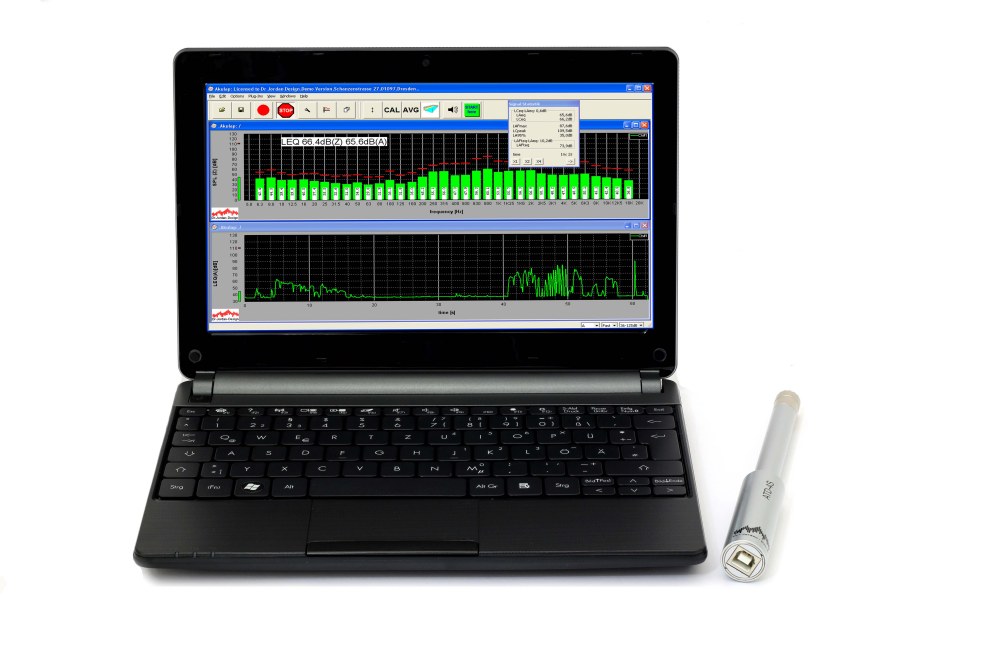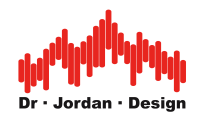Loudness measurement in sone according to DIN 45631 ISO 532B
In this article we cover the measurement of loudness for stationary (not fluctuating noise sources). We offer a turn-key solution for loudness measurement.
In our Webshop you will find many products with focus to audio measurements.
In addition to the simple ISO532B Zwicker method, we offer more complex time-variant loudness measurements and other psycho-acoustic parameters (Sharpness, roughness, tonality etc.).
Introduction
Sound can be described with various physical parameters e.g. intensity, pressure or energy. These parameters are very limited to describe the perception of the human ear. A first approach is to take into account, that the ear is less sensitive at lower and higher frequencies. The research work around 1920 from Barkhausen result into the well known A,C and other weighting curves. These curves are most widely used and are included in almost any sound level meter.
But, which curve is valid?
Today almost any sound level measurement uses the A-curve. The A curve has the strongest attanuation for lower and higher frequencies. If you measure with A instead of C you get lower SPL reading. If you need low results for e.g. product advertisement, choose A. This approach is valid, as long as you mention the weighting curve.
A pure sine at lower levels e.g. 40dB(A) has the same subjective loudness over the complete frequency range.
**But, does the A curve really match with our perception? **
No, it does not. The A curve is defined as an average curve at a sound level of around 40dB. In addition, the curve is simplified, allowing an analog filter with very few components. You can easily implement the A curve with a well defined RC-network. This is one of the reason, why it is widely spread and even included in an 20$ sound level meter.
Unfortunatly, the frequency response of our ear depends on the level. There is not only one curve, there are many
Real world signals are not single tones
The A curve and others are valid for pure tones, only. However, in practice sine tones are not very common. For complex sounds and noise, measuring with A-weighting does not give reasonable results.
Loudness (sone)
A wideband noise has a different subjective loudness than a pure tone at the same level measured in dB(A). Therefore, dB(A) is very limited in its usage although widely used. Zwicker analyzed various psychoacoustics effects thoroughly. A result was a model for the human hearing.
acoustical masking
A famous psychoacoustics effect is acoustical masking. A loud tone hides quiet tones. Nobody would expect to hear the sound of a mouse during a symphonic orchestra, although the mouse would audible in quiet phases. A very famous application of this and other effects are audio compression techniques like MP3. Only parts of the signal, which are audible according to a model, are stored.
Loudness
Based on its countless hearing tests, Zwicker developed a model for loudness measured in sone. For stationary signals you will achieve much better results than the traditional dB(A).
sone is linear not logarithmic
In contrast to dB(A) sone is a linear parameter. Two sone has double loudness compared to one sone. The reference level is one sone, which is equivalent to a tone with 1kHz at a level of 40dB.
limits of a loudness model
This measurement describes the subjective loudness. However, it does not allow distinguishing between nice or annoying tones. Most people will agree that the sound of a flute is much nicer than a drill used by dentist although they both might have the same loudness.
time-invariant (stationary) model ISO532B
As mentioned previously, sone according to ISO532B is valid for stationary signals, only. It is ideally in the judgment of air conditioners or typical PC noise like hard disks of fans.
time-variant (general) model ISO532-1 DIN45631/A1
Real world signals are mostly not constant. They change over time. A sound level meter would show strong fluctuations. Therefore we use time-weighting or averaging .e.g. the famous F (fast) and S (slow) setting on a sound level meter. However, F and S are historic. The are leftovers from analog measurement intruments and can be very simply integrated to a sound level meter.
They are NOT related to our perceptions. Our ear is time-variant and handles signals in a very complex way.
Today, we have proven and well standardizid algorithms (the loudness model) to measure noise in a more generic way.
Typical implementation
Loudness measurement is far beyound a simple sound level meter. The calculation is very complex. However, modern PC can handle this easily.
By using small notebooks , you can easily build a mobile measurement system. The large color display gives you a quick overview of all relevant parameters.

Akulap is a professional Windows application for powerful real-time signal and system analysis. By using the PC environment, it is not only a cost efficient replacement for classical laboratory equipment. AkuLap offers more powerful features combined with a comfortable user interface. Typical applications are acoustic measurements, room and building acoustics and noise monitoring. If you run Akulap on a notebook or even a tablet PC, you can easily build a mobile measurement system.
Features of Akulap:
- With the large display it is very user-friendly compared to classic hand held sound level meters
- Measurement of noise according to international standards
- Measure all parameters simultaneously e.g. LCeq, Lceq, LAFmax, Lcpeak,LAFTeq,L95% etc
- Real-time 1/3 octave analyzer
- FFT analysis
- Level vs. Time plots
- Signal statistics
- Audio recorder (.wav/ .mp3) synchronous to the signal analysis
- Supports Marker for post-processing
- Easy export of measurement results via graphic or table (CSV)
- You can use different signal acquisition hardware. e.g. USB class 1 / 2 microphones Akulap runs on different PC, notebook, tablet with Microsoft windows installed XP/vista/7/8/10/11 32/64bit
Psycho-acoustics with Akulap:
- Loudness in Sone DIN 45631/A1 ISO 532-1
- Specific Loudness
- Loudness time-invariant ISO 532B (classical Zwicker Model)
- Sharpness DIN 45692
- Tonal components DIN 45681
- Tonal analysis for wind turbines IEC61400-1
- Roughness (Daniel & Weber)
- Impulsiveness
- Modulation analysis AM/FM
- GMW18141 and GMW14155: Laboratory Evaluation of Mechanical Sounds Produced by Electrical Switches. This procedure describes a laboratory method for evaluating component sound quality metrics for automotive customer actuated switches. It is applicable for any physical switches used by vehicle occupants to actuate specific functions, such as toggle switches, push buttons, rockers, etc.
- ECMA 418-1 Annex B ITT equipment Part 1 (prominent discrete tones)
The measurement of the loudness is based on the 1/3 octave analyzer. In addition, you have to calibrate the system. All psycho acoustic analysis requires absolute sound levels. This can be achieved with a sound level calibrator.


